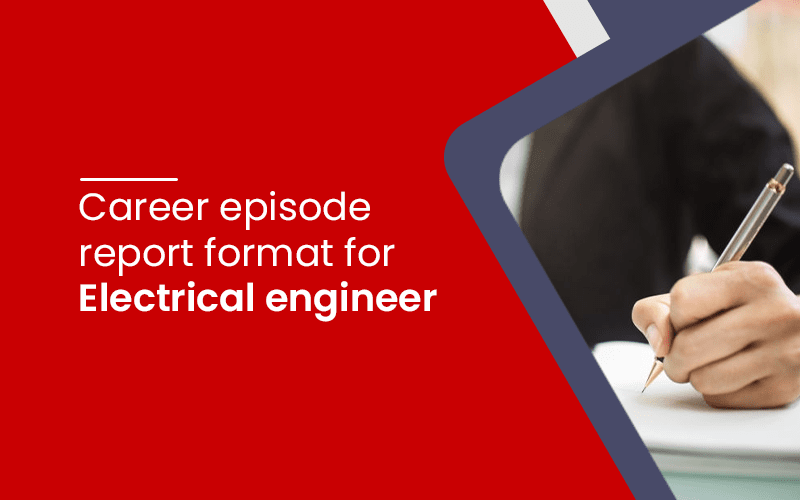Career Episode Format for Electrical Engineer

Table of Contents
Electrical Engineer Designs create and manage the production, installation, operation, and maintenance of equipment, machinery, and systems used to generate, distribute, and control electric power. It is possible that registration or licensing will be required. Electrical engineers design, build and test electrical devices and hardware such as communication frameworks, power generators, engines and routing frameworks, and electrical frameworks for automobiles and aeroplanes. They also oversee the assembly of various devices, frameworks, and hardware.
Engineers Australia requires migrant engineers to submit three career episode reports for their competency demonstration report (CDR) (CERs). Engineers Australia’s Career Episode Report gives detailed information about an engineer’s technical and other talents relevant to the project at hand. You must demonstrate your professional qualities in your career episodes. An example of a Career Episode Report for an Electrical Engineer is shown below.
PART-I INTRODUCTION
CE 1.1
The career episode is based on the project “BUCHI Unit for Protein Analysis.” I completed this assignment while working as an Executive Trainee in the Manufacturing Department. The XXX represents the name of the firm where I was employed at the time (name and location of company). Between September and December of 2014, the project was successfully finished.
PART-II BACKGROUND
CE 1.2
XXX (Company Name) is a branch of XXX (Company Name), which has its headquarters in XXX (Company’s Location). Both companies operate independently and have distinct headquarters; XXX (Company Name) is headquartered in DLF XXX (location), whilst Pharmaceuticals is headquartered in XXX (Location). The XXX site became the Indian mother plant, manufacturing Horlicks and its variants for the Indian market. The plant has a yearly capacity of roughly 100,000 metric tons.
Currently, XXX (Company Name) has three separate manufacturing locations that produce the same product, but XXX (Company Name) outperforms incapacity. Protein calculations are crucial in the food and chemical industries. However, the process involves handling chemicals such as sulfuric acid and organic liquids, and the old equipment utilized in the process had heated surfaces and was not shockproof. As a result, it is thought necessary to improve the analyst’s safety and the efficiency of the protein calculation system in terms of energy savings, which is carried out in this project.
CE 1.3
The primary goal of this project is to improve the BUCHI Unit for Protein Analysis’s efficiency. The following are the project’s particular objectives:
- to assess present system risks and challenges
- To increase the analyst’s safety throughout the protein calculating procedure.
- to create a new system that meets the criteria while minimizing possible hazards
- To set up the new system
- To be put into service under the supervision of the safety manager.
- Trials will be conducted to evaluate the new system.
- to improve the protein calculating system’s efficiency in terms of energy savings
- to create an energy usage data analysis report
CE 1.4
Under the guidance of Mr X, I completed this project for the organization XXX (Company Name and Location). This project’s organizational structure is as follows:
 CE 1.5
CE 1.5
The following are the duties and responsibilities that I fulfilled while working on this project:
- The sort of glass to be used must be resistant to acids, alkalis, and organic compounds.
- To guarantee that there are no leaks of dangerous acid gases.
- To determine the size of the condensation zone to prevent acid splashing.
- To work with the process engineer to achieve a flawless installation.
- Examine the new equipment’s design and its compatibility with the product to be evaluated for protein calculation.
- To examine the data in terms of total time spent by the old and new systems.
- To assess the system’s efficiency in terms of energy usage.
PART-III PERSONAL ENGINEERING ACTIVITY
CE 1.6
My theoretical knowledge earned throughout my undergraduate education was turned into practical applications, which are stated below:
- I utilized my expertise in chemical engineering to calculate the proper amount of sulfuric acid to use that is non-toxic and safe for both humans and the environment.
- I utilized my understanding of material selection to choose the appropriate ingredients for the culinary product.
- I used my mathematical expertise to determine the size of the new system such that it took less time to complete one cycle than the prior system.
- I used my understanding of the chemical system’s safety PPE requirements to improve the analyst’s safety.
- Using my understanding of maintenance engineering, I conducted preventative maintenance on the new system.
CE 1.7
The fumes produced during the protein-digesting process must be kept under control. I researched numerous publications, papers, and studies on the issue of operator safety throughout procedures. Condensation zones are hot surfaces and places that are harmful to the operator and cannot be entered without adequate verification throughout the operation.
The condensation zones are determined to prevent acids from splashing on the operator. The discharge of acid fumes into the air was extremely dangerous, so I researched ways to regulate them and convert them into a less harmful substance or gas that might be used in other applications. I discovered that the vapors could be concentrated and collected in a tank. I researched the pollution control guidelines that a food and beverage manufacturing organization must follow.
CE 1.8
I chose the materials needed to meet the specifications of the new system design. I picked a system with a shock and temperature-proofing body. I used a fireclay to insulate the BUCHI system’s surface plates. As a fill level sensor, I utilized a Hall Effect sensor. A safety sensor is chosen that continually checks the system’s temperature and stops heating when the temperature reaches a critical limit. The specific dose of sulfuric acid is calculated since this acid is quite powerful, and the protein analysis method necessitates the analyst’s handling of the acid.
This technique necessitates the use of chemically resistant, thermally, and shockproof glass. So I went with the Borosilicate glass 3.3, which has all of the needed qualities. Infrared rays were used as the system’s heating medium.
CE 1.9
In the first stage of my study, I tackled the challenges associated with unregulated heating. The previous technique included gas burners to heat the glass tubes used in protein calculations. The heating system was manually managed, resulting in bursting and chemical spills in some situations if not adequately monitored. Because of the unregulated heating system, the analyst may suffer safety hazards in some instances.
The new system, known as the BUCHI system, was created by myself. It was outfitted with safety sensors that continually monitored the system’s temperature. Infrared rays were used as the heating medium in this case. When the temperature exceeds a threshold level, the safety sensor activates, turning the heating off. The risk of rupture and chemical leakage is much decreased in this controlled environment.
CE 1.10
Following that, I investigated the hot surface and electric shock issues in the system. The current system is an open system with heated surfaces that may burn you. There was also a substantial possibility of electric shocks. It is exceedingly unsafe for an analyst to handle the glass tubes while working on the system, even with safe handling equipment.
I created a novel system with unique stress absorption and a thermally resistant body. The plates on the surface of the BUCHI system were insulated by inserting a fireclay. I ran the calculations to determine the size of the new system such that it took less time to complete one cycle than the prior system. This covered the size of the tubes and the critical temperature limit at which the heating would halt. I worked out the crucial temperature limit.
CE 1.11
I created the channel for the acid fumes to exit from the system to ensure good condensation and to use the least space. Then I devised a system that included a suction device linked to all of the tubes coming from their mouths. The suction unit’s function was to pull out the harmful vapors, removing the likelihood that these vapors might mix with the laboratory air and reducing the risk.
Sulfuric acid was the primary chemical employed in the protein-digesting process, resulting in acid vapors. On the other hand, the existing arrangement had a chimney put on the top of the chamber, but there was a risk that the acid fumes would not leave correctly and might mix with the laboratory air. If the analyst swallowed the vapors, they would be in danger. As a result, I presented the new method while keeping these issues in mind.
CE 1.12
I took into account all of the aforementioned design steps before installing the new system. The installation in XXX (Company Name) went off without a hitch. The installation of the BUCHI unit increased the analyst’s safety and the protein calculating system’s efficiency in terms of energy savings. Under the supervision of the safety manager, I also commissioned the new system. Following that, I tested the system’s functionality.
I initially tested the system on the water to ensure that all of the system’s components were in good working order. After some hits and tries, the testing came out positive. The suction device was checked to see whether there was any fume leakage. The tests were successful, and no vapours were detected in the laboratory air or, as a result, in the surrounding air.
CE 1.13
After the testing was done, the new system was put into full operation. Because the test findings were all positive, the new system was approved for usage. Then, for maximum productivity, I did periodic maintenance on the new system. I was in charge of the daily maintenance, which included turning the system units on and off. I also performed weekly maintenance, which included lubricating the moving parts. I was in charge of the calendar maintenance because the sensors could only be used for 2000-3000 hours.
CE 1.14
Technical difficulties
The glass that was being utilized for the chemical analysis was not resistant to acids, alkalis, or organic compounds. It did not additionally absorb the shocks, and this posed a major health risk to the analyst. After careful consideration with the lab attendant and the process engineer, I determined that the glass should be chemically resistant, thermally stable, and shockproof. Chemically, Borosilicate glass 3.3 possessed all of the needed qualities, which DURAN eventually offered.
The vapours sent into the atmosphere by sulfuric acid and other organic liquids polluted the environment.
After passing it through the suction tube, it was exceedingly unsafe to do so since it posed several health dangers to both humans and the species surrounding the spot. As a result, I opted to utilize a sulfuric acid condenser, which was then collected in a tank.
CE 1.15
The vapours sent into the atmosphere by sulfuric acid and other organic liquids polluted the environment. Even after passing it through the suction tube, it was exceedingly unsafe to do so since it posed several health dangers to both humans and the species surrounding the spot. As a result, I opted to utilize a sulfuric acid condenser, which was then collected in a tank.
I also collaborated with Mr A, the process engineer, and Mr B, the Quality Analyst, to identify possible hazards in the existing and new systems. I used to have weekly meetings with the plant manager every Monday after the morning meeting to discuss progress, ongoing concerns and allocated duties for the week. Every Tuesday morning, I would meet with my Manager, Mr X, to discuss the important topics. In doing so, I followed the company’s laws and regulations while maintaining my standards and ethics throughout the assignment. Because sulfuric acid vapours are extremely toxic, the predefined limits of the acid are utilized to calculate the permitted exposure limit, which is 0.1mg/m3 to 3mg/m3 STEEL.
PART-IV SUMMARY
CE 1.16
Working on a chemical analysis project has never been easy since we have to consider a variety of aspects and scenarios in order to accomplish an activity. A chemical process includes the processing of hazardous chemicals and organic substances. Working on this project allowed me to use my academic knowledge in a real setting. During this endeavour, I learned time management and self-discipline. The previous system had safety problems, but the new system checks all safety issues, and the environmental impact is also minimal due to the many accessories utilized to check all CCPs.
The project was well-managed, and the project goals and objectives were met on time. However, the time required for this project was increased by one month to complete all safety tests. I used my analytical abilities to reach a fair conclusion. The Manufacturing, Quality, and Engineering teams were in charge of the total project. To attain our objectives, we collaborated as a group. My job in the project entailed using the proper materials and equipment to maximize productivity.
CDRWritersAustralia for Assistance
CDRWritersAustralia can help you complete your CDR, RPL, and KA02 reports by supplying qualified Engineers and ICT professionals. We give work reference letters, complete RPL reports, and CDR report sample generation in Australia. All following reports will be based on your academic or employment project reports.
Recent Posts
- Benefits of RPL Writing for Professional Advancement—Seize the Opportunity! July 8, 2024
- Unlocking Your Potential: Benefits of NER Registration for Engineers—Don’t miss out! July 4, 2024
- 8 Advantages of being a Registered NER Engineer April 25, 2024
- Stage 1 Competency Standard for Professional Engineer December 4, 2023
- Secure Your Future: The Most In Demand Jobs for Skilled Migrants to Australia in 2024 November 3, 2023






